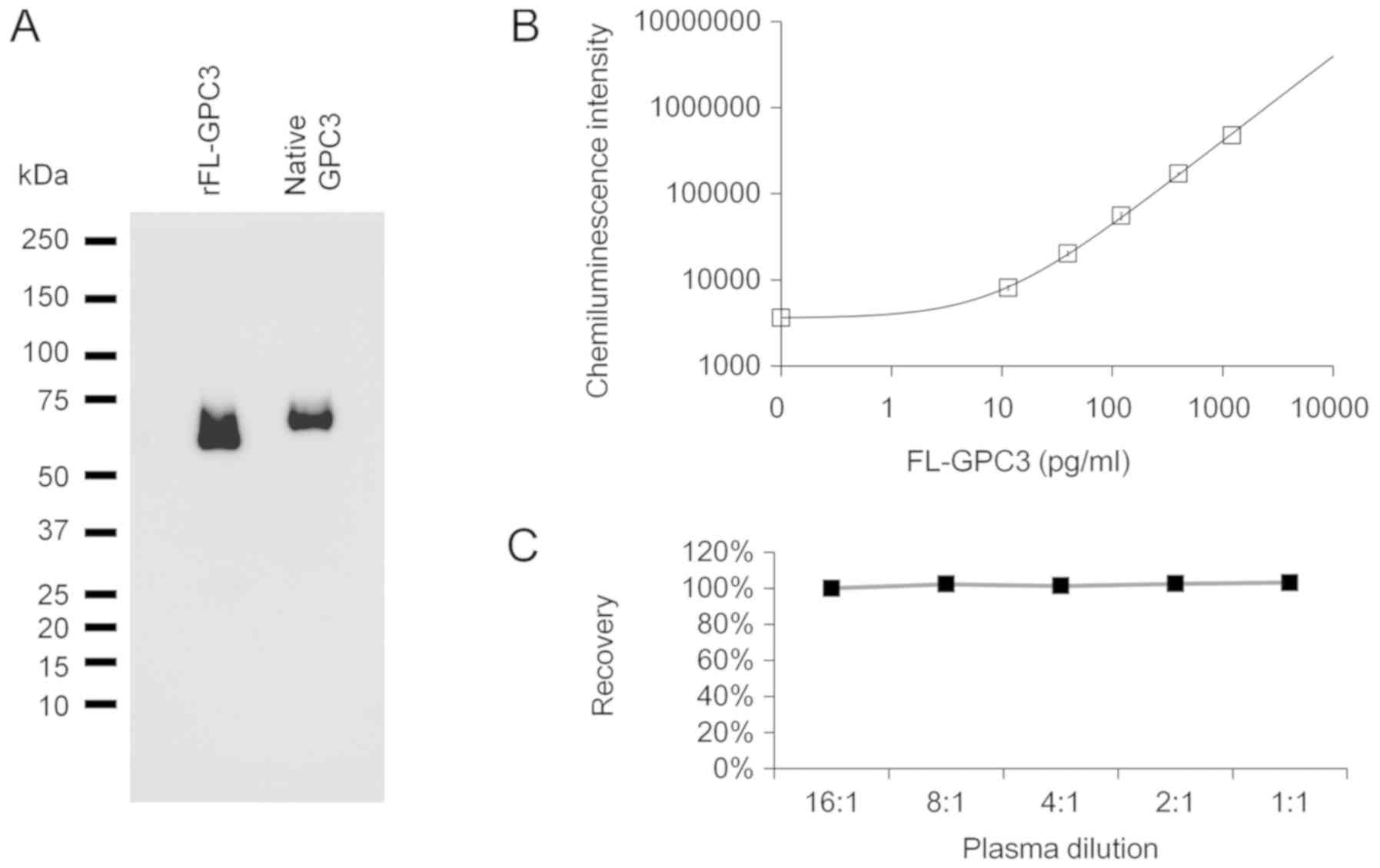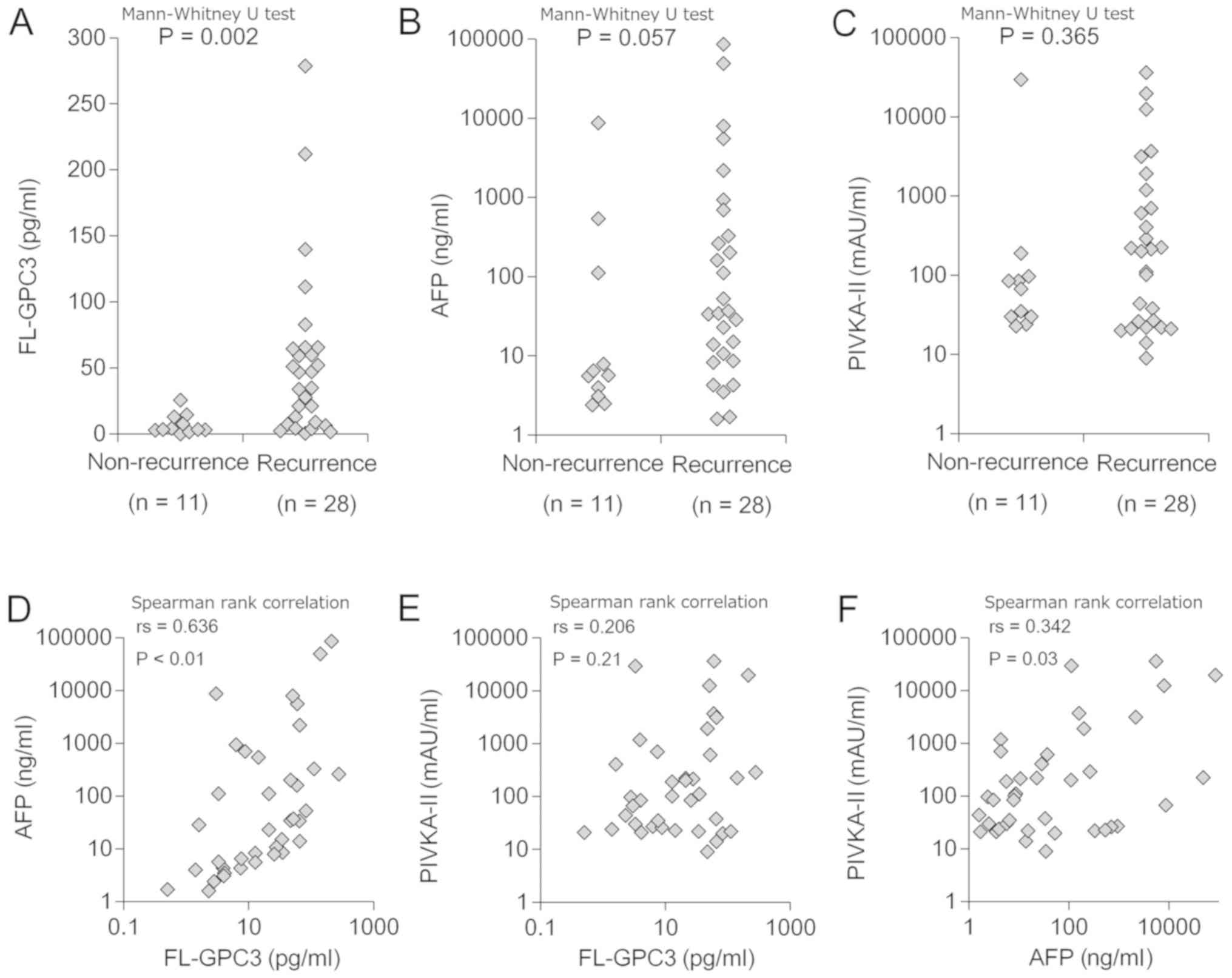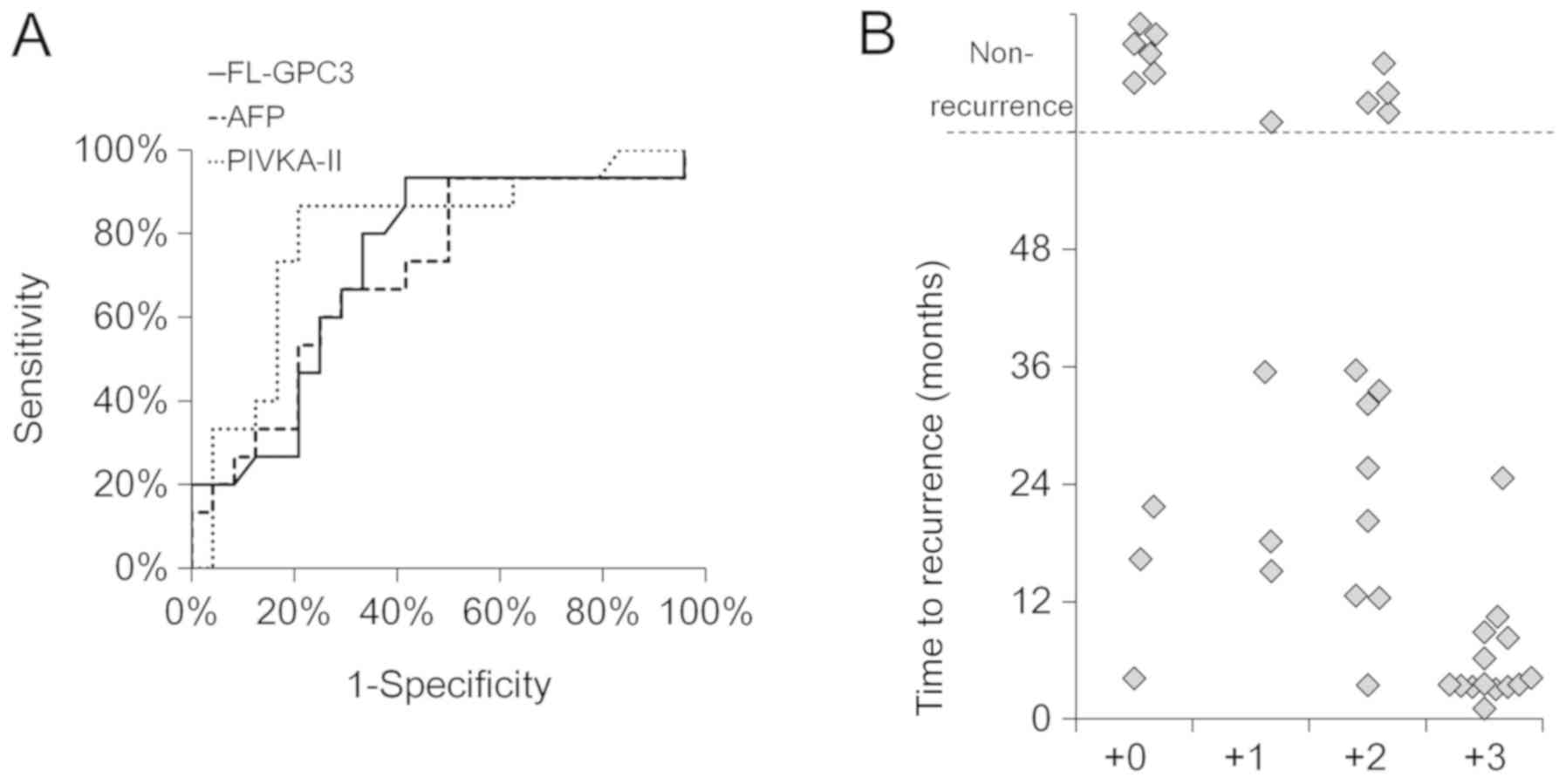|
1
|
Jemal A, Bray F, Center MM, Ferlay J, Ward
E and Forman D: Global cancer statistics. CA Cancer J Clin.
61:69–90. 2011. View Article : Google Scholar : PubMed/NCBI
|
|
2
|
Sawada Y, Yoshikawa T, Ofuji K, Yoshihura
M, Tsuchiya N, Takahashi M, Nobuoka D, Gotohda N, Takahashi S, Kato
Y, et al: Phase II study of the GPC3-derived peptide vaccine as an
adjuvant therapy for hepatocellular carcinoma patients.
Oncoimmunology. 5:e11294832016. View Article : Google Scholar : PubMed/NCBI
|
|
3
|
Toyoda H, Kumada T, Osaki Y, Oka H, Urano
F, Kudo M and Matsunaga T: Staging hepatocellular carcinoma by a
novel scoring system (BALAD score) based on serum markers. Clin
Gastroenterol Hepatol. 4:1528–1536. 2006. View Article : Google Scholar : PubMed/NCBI
|
|
4
|
Carr BI, Kanke F, Wise M and Satomura S:
Clinical evaluation of lens culinaris agglutinin-reactive
alpha-fetoprotein and des-gamma-carboxy prothrombin in
histologically proven hepatocellular carcinoma in the United
States. Dig Dis Sci. 52:776–782. 2007. View Article : Google Scholar : PubMed/NCBI
|
|
5
|
Bayati N, Silverman AL and Gordon SC:
Serum alpha-fetoprotein levels and liver histology in patients with
chronic hepatitis C. Am J Gastroenterol. 93:2452–2456. 1998.
View Article : Google Scholar : PubMed/NCBI
|
|
6
|
Shirakawa H, Kuronuma T, Nishimura Y,
Hasebe T, Nakano M, Gotohda N, Takahashi S, Nakagohri T, Konishi M,
Kobayashi N, et al: Glypican-3 is a useful diagnostic marker for a
component of hepatocellular carcinoma in human liver cancer. Int J
Oncol. 34:649–656. 2009.PubMed/NCBI
|
|
7
|
Shirakawa H, Suzuki H, Shimomura M, Kojima
M, Gotohda N, Takahashi S, Nakagohri T, Konishi M, Kobayashi N,
Kinoshita T and Nakatsura T: Glypican-3 expression is correlated
with poor prognosis in hepatocellular carcinoma. Cancer Sci.
100:1403–1407. 2009. View Article : Google Scholar : PubMed/NCBI
|
|
8
|
Wang HL, Anatelli F, Zhai QJ, Adley B,
Chuang ST and Yang XJ: Glypican-3 as a useful diagnostic marker
that distinguishes hepatocellular carcinoma from benign
hepatocellular mass lesions. Arch Pathol Lab Med. 132:1723–1728.
2008.PubMed/NCBI
|
|
9
|
Nakatsura T, Kageshita T, Ito S, Wakamatsu
K, Monji M, Ikuta Y, Senju S, Ono T and Nishimura Y: Identification
of glypican-3 as a novel tumor marker for melanoma. Clin Cancer
Res. 10:6612–6621. 2004. View Article : Google Scholar : PubMed/NCBI
|
|
10
|
Toretsky JA, Zitomersky NL, Eskenazi AE,
Voigt RW, Strauch ED, Sun CC, Huber R, Meltzer SJ and Schlessinger
D: Glypican-3 expression in Wilms tumor and hepatoblastoma. J
Pediatr Hematol Oncol. 23:496–499. 2001. View Article : Google Scholar : PubMed/NCBI
|
|
11
|
Saikali Z and Sinnett D: Expression of
glypican 3 (GPC3) in embryonal tumors. Int J Cancer. 89:418–422.
2000. View Article : Google Scholar : PubMed/NCBI
|
|
12
|
Capurro M, Wanless IR, Sherman M, Deboer
G, Shi W, Miyoshi E and Filmus J: Glypican-3: A novel serum and
histochemical marker for hepatocellular carcinoma.
Gastroenterology. 125:89–97. 2003. View Article : Google Scholar : PubMed/NCBI
|
|
13
|
De Cat B, Muyldermans SY, Coomans C,
Degeest G, Vanderschueren B, Creemers J, Biemar F, Peers B and
David G: Processing by proprotein convertases is required for
glypican-3 modulation of cell survival, Wnt signaling, and
gastrulation movements. J Cell Biol. 163:625–635. 2003. View Article : Google Scholar : PubMed/NCBI
|
|
14
|
Ho M and Kim H: Glypican-3: A new target
for cancer immunotherapy. Eur J Cancer. 47:333–338. 2011.
View Article : Google Scholar : PubMed/NCBI
|
|
15
|
Haruyama Y, Yorita K, Yamaguchi T,
Kitajima S, Amano J, Ohtomo T, Ohno A, Kondo K and Kataoka H: High
preoperative levels of serum glypican-3 containing N-terminal
subunit are associated with poor prognosis in patients with
hepatocellular carcinoma after partial hepatectomy. Int J Cancer.
137:1643–1651. 2015. View Article : Google Scholar : PubMed/NCBI
|
|
16
|
Nakatsura T, Yoshitake Y, Senju S, Monji
M, Komori H, Motomura Y, Osaka S, Beppu T, Ishiko T, Kamohara H, et
al: Glypican-3, overexpressed specifically in human hepatocellular
carcinoma, is a novel tumor marker. Biochem Biophys Res Commun.
306:16–25. 2003. View Article : Google Scholar : PubMed/NCBI
|
|
17
|
Filmus J, Capurro M and Rast J: Glypicans.
Genome Biol. 9:2242008. View Article : Google Scholar : PubMed/NCBI
|
|
18
|
Capurro M and Filmus J: Glypican-3 as a
serum marker for hepatocellular carcinoma. Cancer Res. 65:372–373.
2005.PubMed/NCBI
|
|
19
|
Hippo Y, Watanabe K, Watanabe A,
Midorikawa Y, Yamamoto S, Ihara S, Tokita S, Iwanari H, Ito Y,
Nakano K, et al: Identification of soluble NH2-terminal fragment of
glypican-3 as a serological marker for early-stage hepatocellular
carcinoma. Cancer Res. 64:418–423. 2004. View Article : Google Scholar
|
|
20
|
Chen M, Li G, Yan J, Lu X, Cui J, Ni Z,
Cheng W, Qian G, Zhang J and Tu H: Reevaluation of glypican-3 as a
serological marker for hepatocellular carcinoma. Clin Chim Acta.
423:105–111. 2013. View Article : Google Scholar : PubMed/NCBI
|
|
21
|
Beale G, Chattopadhyay D, Gray J, Stewart
S, Hudson M, Day C, Trerotoli P, Giannelli G, Manas D and Reeves H:
AFP, PIVKAII, GP3, SCCA-1 and follisatin as surveillance biomarkers
for hepatocellular cancer in non-alcoholic and alcoholic fatty
liver disease. BMC Cancer. 8:2002008. View Article : Google Scholar : PubMed/NCBI
|
|
22
|
Ozkan H, Erdal H, Kocak E, Tutkak H,
Karaeren Z, Yakut M and Koklu S: Diagnostic and prognostic role of
serum glypican 3 in patients with hepatocellular carcinoma. J Clin
Lab Anal. 25:350–353. 2011. View Article : Google Scholar : PubMed/NCBI
|
|
23
|
Capurro M, Shi W, Izumikawa T, Kitagawa H
and Filmus J: Processing by convertases is required for
glypican-3-induced inhibition of Hedgehog signaling. J Biol Chem.
290:7576–7585. 2015. View Article : Google Scholar : PubMed/NCBI
|
|
24
|
Poon RT, Ng IO, Fan ST, Lai EC, Lo CM, Liu
CL and Wong J: Clinicopathologic features of long-term survivors
and disease-free survivors after resection of hepatocellular
carcinoma: A study of a prospective cohort. J Clin Oncol.
19:3037–3044. 2001. View Article : Google Scholar : PubMed/NCBI
|
|
25
|
Gao W, Tang Z, Zhang YF, Feng M, Qian M,
Dimitrov DS and Ho M: Immunotoxin targeting glypican-3 regresses
liver cancer via dual inhibition of Wnt signalling and protein
synthesis. Nat Commun. 6:65362015. View Article : Google Scholar : PubMed/NCBI
|
|
26
|
El-Saadany S, El-Demerdash T, Helmy A,
Mayah WW, Hussein BE, Hassanien M, Elmashad N, Fouad MA and Basha
EA: Diagnostic value of Glypican-3 for hepatocellular carcinomas.
Asian Pac J Cancer Prev. 19:811–817. 2018.PubMed/NCBI
|
|
27
|
Chen IP, Ariizumi S, Nakano M and Yamomoto
M: Positive glypican-3 expression in early hepatocellular carcinoma
predicts recurrence after hepatectomy. J Gastroenterol. 49:117–125.
2014. View Article : Google Scholar : PubMed/NCBI
|
|
28
|
Ofuji K, Saito K, Suzuki S, Shimomura M,
Shirakawa H, Nobuoka D, Sawada Y, Yoshimura M, Tshuchiya N,
Takahashi M, et al: Perioperative plasma glypican-3 level may
enable prediction of the risk of recurrence after surgery in
patients with stage I hepatocellular carcinoma. Oncotarget.
8:37835–37844. 2017. View Article : Google Scholar : PubMed/NCBI
|
|
29
|
Kaseb AO, Hassan M, Lacin S, Abdel-Wahab
R, Amin HM, Shalaby A, Wolff RA, Yao J, Rashid A, Vennapusa B, et
al: Evaluating clinical and prognostic implications of Glypican-3
in hepatocellular carcinoma. Oncotarget. 7:69916–69926. 2016.
View Article : Google Scholar : PubMed/NCBI
|
|
30
|
Imamura H, Matsuyama Y, Tanaka E, Ohkubo
T, Hasegawa K, Miyagawa S, Sugawara Y, Minagawa M, Takayama T,
Kawasaki S and Makuuchi M: Risk factors contributing to early and
late phase intrahepatic recurrence of hepatocellular carcinoma
after hepatectomy. J Hepatol. 38:200–207. 2003. View Article : Google Scholar : PubMed/NCBI
|
|
31
|
Zhang D, Liu Z, Yin X, Qi X, Lu B, Liu Y
and Hou J: Prognostic value of PIVKA-II in hepatocellular carcinoma
patients receiving curative ablation: A systematic review and
meta-analysis. Int J Biol Markers. 33:266–274. 2018. View Article : Google Scholar : PubMed/NCBI
|
|
32
|
Abbasi A, Bhutto AR, Butt N and Munir SM:
Corelation of serum alpha fetoprotein and tumor size in
hepatocellular carcinoma. J Pak Med Assoc. 62:33–36.
2012.PubMed/NCBI
|
|
33
|
Poté N, Cauchy F, Albuquerque M, Voitot H,
Belghiti J, Castera L, Puy H, Bedossa P and Paradis V: Performance
of PIVKA-II for early hepatocellular carcinoma diagnosis and
prediction of microvascular invasion. J Hepatol. 62:848–854. 2015.
View Article : Google Scholar : PubMed/NCBI
|
|
34
|
Imamura H, Matsuyama Y, Miyagawa Y, Ishida
K, Shimada R, Miyagawa S, Makuuchi M and Kawasaki S: Prognostic
significance of anatomical resection and des-gamma-carboxy
prothrombin in patients with hepatocellular carcinoma. Br J Surg.
86:1032–1038. 1999. View Article : Google Scholar : PubMed/NCBI
|
|
35
|
Yamanaka N, Okamoto E, Toyosaka A,
Mitunobu M, Fujihara S, Kato T, Fujimoto J, Oriyama T, Furukawa K
and Kawamura E: Prognostic factors after hepatectomy for
hepatocellular carcinomas. A univariate and multivariate analysis.
Cancer. 65:1104–1110. 1990. View Article : Google Scholar : PubMed/NCBI
|


















